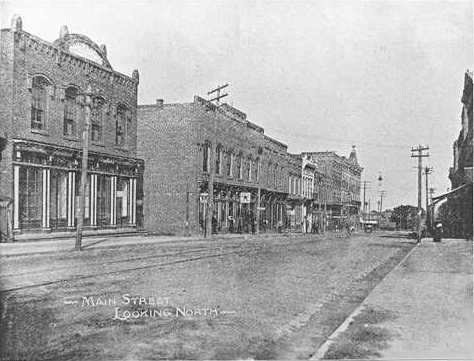
Rock Hill - 1880's and 90's
In 1880, little law enforcement let crime get out of hand at times. Most men drank in the grog shops. Catawba Indians made their living traditionally by making crafts and goods to sell while others left the Reservation for sharecropping jobs. Rock Hill’s cotton business was limited to a radius of about 15 miles; the limit a mule could pull a wagon of cotton. James Ivy raised local capital and built the Rock Hill Cotton Factory. It was one of the first post-war cotton factories in the state, and the first that was powered by steam. The Rock Hill Cotton Factory was incorporated in 1880 and began operations in 1881. (Shareholders and Board of Directors included Captain A. E. Hutchinson – President, The White Family, Hiram Hutchinson, A. H. White, W. C. Roddey, J. R. London, W. B. Fewell, F. J. Pelzer, John Grill, and David Hutchinson – Secretary.) Rock Hill Cotton Factory is known today as Ostrow Textile Mills.
A special election in 1881 closed saloons in town and Rock Hill became the first city in South Carolina to enact prohibition. As a result, Rock Hill would be described fourteen years later as a well-behaved place, high-toned and moral with the rum traffic forever blotted from Rock Hill’s History.

Other mills that were built and operated in Rock Hill were the Standard Mill (1887), The Globe Mill (1889), the Arcade Mill (1896), and the Manchester Mill (1896). (The previous are known today as the Highland Park Mill – Converted into a senior-citizens apartment dwelling, Victoria Mill, Arcade Mill – burned down several years ago, and the Industrial Mill – one smoke stack and central column left after demolition, respectively) Rock Hill initially did not have the capital to build the desperately needed Standard Mill, but the communities around the location for the mill invested at least something to the building of the mill. Once built, the Standard Mill provided for 280 jobs
In 1888, the State of South Carolina announced an open bid for the new Winthrop Normal and Industrial College of South Carolina. On March 27, 1893, the citizens of Rock Hill voted and passed a referendum for a $60,000 bond, 30 acres in Oakland Park, cash gift of $700, and 375,000 bricks for the state bid. Other South Carolina cities argued that Rock Hill could not afford a debt this size, but A. E. Hutchinson would telegraph the state board confirming that the Hutchinson family would pay the $60,000 bond. Winthrop College would open in Rock Hill in 1895 with 20 instructors and 300 students.
The offerings of African American Baptist Sunday Schools in 1891 bought 9 acres of land for a school. Friendship School was built on that land and opened for African American children on October 12th, 1891. Eleven students and their teacher, the Reverend M. P. Hall was the first class. Noah A. Crockett founded Clinton School in 1894, and the Reverend M. P. Hall taught the first class.
Alexander Graham Bell invented the telephone in 1876, and Charlotte had a telephone exchange of the Bell Company by 1885. John Gary Anderson asked that Rock Hill be offered service from Charlotte, but was refused with the reasoning that the Bell Company could not profit from offering service in Rock Hill. A Mr. Mason of Sumter had built his own telephone and sold it to Mr. Anderson, who strung a wire from his buggy shop on Caldwell Street to the Train Depot in order to check freight shipments from his store. Soon after, Mr. Anderson signed up subscribers and bought a 25-line switchboard. (The first subscriber was Andrew J. Evans.) Before the first line was installed, more businesses subscribed and Mr. Anderson soon bought a 100-line switchboard. A. R. Smith and J. M. Cherry became partners with Mr. Anderson and on December 21, 1895, incorporated the Rock Hill Telephone Company. Mr. Anderson sold the Telephone Company to Paul Workman and A. R. Smith for $3,000. The Rock Hill Telephone Company was sold again in 1912 to the Edward Ladson Barnes family, whose great-grandson, Bryant Barnes, is president of the company today, branded as Comporium Communications.
In 1890, the first electric plant was built using two engines totaling 225 horsepower, lighting streets, homes, and businesses. Banks in Rock Hill included The Savings Bank in 1886, and The First National Bank in 1887. The Lantern was Rock Hill’s Newspaper in 1872, which changed its name to The Herald in 1874. The Journal was another newspaper started by John G. Anderson and Captain W. L. Roddey in 1901. The name of this newspaper changed to The Record in 1903 and stopped publication in 1930.
In 1889, John G. Anderson and his father-in-law, A. D. Holler, started The Buggy Company. A new plant was built on Laurel Street in 1892 and the company’s name was changed to The Anderson Buggy Company. The Anderson Buggy Company completed buggies at a rate of one per 25 minutes and competed nationally selling throughout the south, Mexico, England, and Cuba.
By 1895, Rock Hill had survived the Civil War, Reconstruction, and the national financial panic of 1893, and had a population of 5,500. William Church Whitner, from Anderson, proposed to build a hydro-electric dam at India Hook on the Catawba River, and joined his brother Robert Whitner and Dr. Gill Wylie to organize the Catawba Power Company. After four years, Whitner sold out to Dr. Wylie. The dam was completed in 1904 and was considered one of the greatest engineering feats in the southeast. Victoria Mills was the first customer, but others soon subscribed in Rock Hill, Fort Mill, and Charlotte. The Plant was sold a few years later to James Buchanan Duke. Years later, the dam was damaged in the Great Flood of 1916, but was rebuilt and extended.